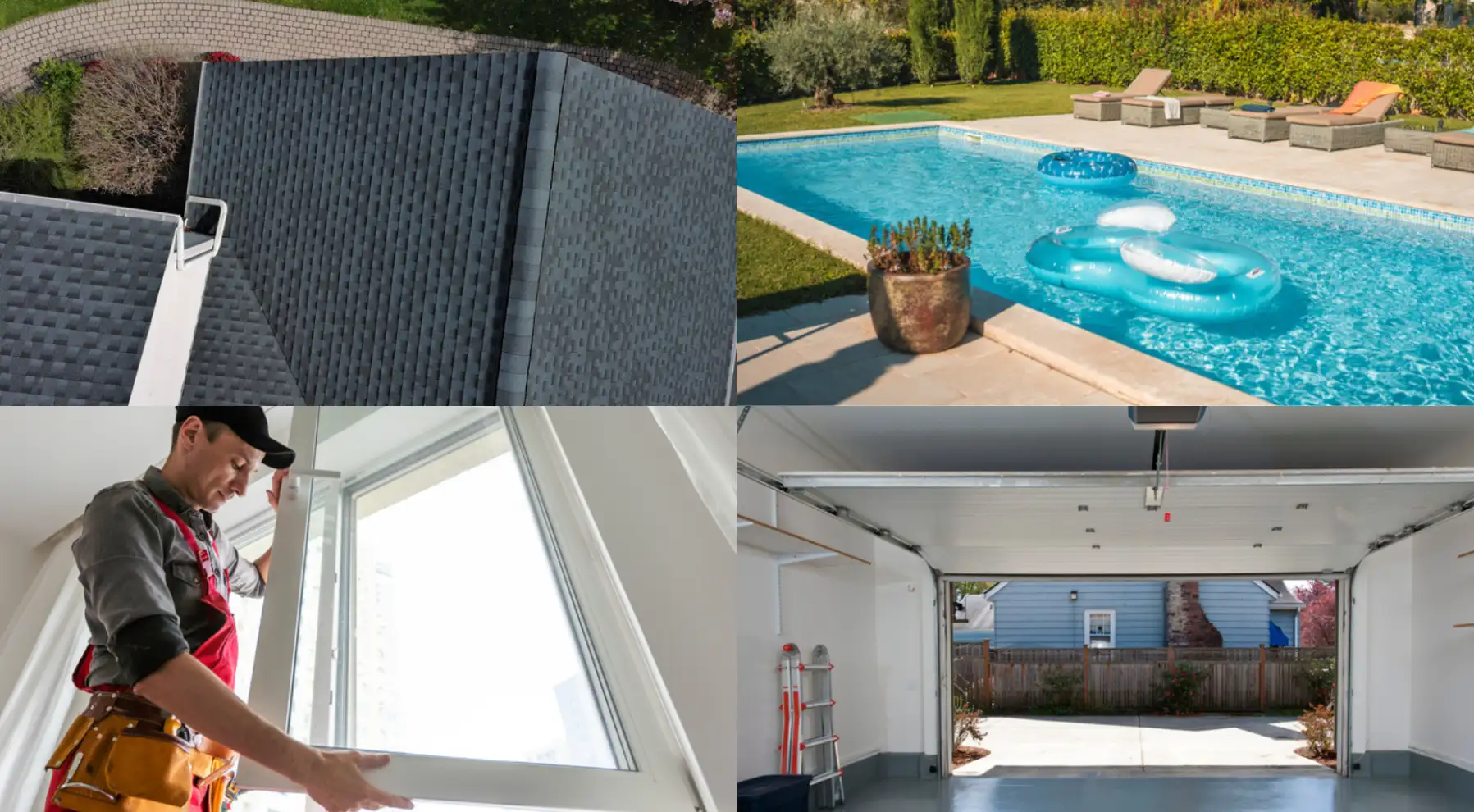3 Home Improvements with the Best ROI (And 3 With the Worst)

Many homeowners assume that any money spent on renovations or upgrades will translate into increased resale value.
The reality is more complex. While some renovations can boost value, not all provide a good return on investment (ROI) and some can actually hurt your bottom line.
3 Renovations With The Highest ROI Potential
While not all renovations add value, some types of updates consistently yield a solid return.
1. Energy-Efficient Upgrades
Buyers are increasingly interested in energy efficiency, so replacing windows, adding insulation, or installing a smart thermostat can add value and help attract buyers. In some areas, government grants or subsidies may help offset the installation of these kinds of upgrades.
2. Roof & AC Replacements
In many markets, the cost of replacing your roof or air condition system can often be entirely offset by an increase in the home’s sale price, especially if your neighbors all have older roofs. Consult with a real estate agent to be sure, but even though these renovations are expensive, they may offer almost 100% ROI.
3. Neutral Colors
Cosmetic updates that look fresh and contemporary appeal to a broader audience. Avoid niche design choices, like installing a Tuscan-inspired kitchen reminiscent of the 90s, and opt for timeless finishes instead. When it comes to touch-ups like painting or updating light fixtures, pick light, neutral colors and styles that can go with anyone’s preferred decor.
3 Renovations That Might Reduce Value
No one likes to hear it, but some renovations can actually lower your home’s value. Here are a few examples of projects that often don’t yield a return, or worse, can actively detract from your home’s appeal.
1. Garage Conversions
In many neighborhoods, a garage is a highly desirable feature. Converting your garage into a living space, like an extra bedroom or gym, may fit your needs, but potential buyers may see the lack of a garage as a drawback. Losing this feature can reduce your property value as buyers may discount their offer by thousands of dollars to cover the restoration cost.
2. Swimming Pools
While pools can sound appealing, especially in warmer climates, they often don’t add enough value to offset installation costs, which can easily reach $50,000 to $100,000. However, a pool typically only adds about $20,000 to $30,000 in home value, and in some regions, it may be even less.
Pools also come with ongoing maintenance costs, and some buyers view them as a liability rather than an asset, particularly if they have young children or don’t want the expense and upkeep of a pool. In colder climates or areas where pools aren’t common, adding one may decrease your home’s marketability and value because of these perceived downsides.
3. Tennis Courts, Saunas, and Other Specialty Additions
Tennis courts cost thousands of dollars to maintain the material they’re made out of, and the cost to tear them up and remove them can be exorbitant. Saunas or steam rooms may require nuanced electrical configurations and structural design that prevents that area from being easily repurposed into something else. A putting green may require specialized lawn maintenance that a new owner isn’t willing to keep up with.
Even affordable upgrades can fall into the same value trap. For example, installing an above-ground hot tub directly into your deck takes up valuable space for an amenity that future buyers may not want. Adding bulky, non-removable office built-ins to a room typically used as a bedroom can also reduce buyer interest, as they may need to budget for its removal. Similarly, adding a large walk-in closet to a smaller bedroom may suit your wardrobe needs, but could make the room feel too cramped or less functional for most potential buyers.
Why Renovations Don’t Always Increase Value
The assumption that any renovation will add value doesn’t take into account the nuances of the housing market. The value of an upgrade often depends on factors like neighborhood norms, buyer preferences, and regional demand. For instance, installing a lavish, modern kitchen may seem like a worthwhile investment, but if the homes in your area have simpler kitchens and attract buyers looking for affordability, the upgrade may not yield a return. The old adage, “you don’t want to own the nicest house on the block” rings true for a reason.
Housing market trends also change over time. An upgrade that is highly desirable today could fall out of favor a few years from now. Features that are unique or highly customized to your tastes may not appeal to future buyers.
A famous and extreme example is Michael Jordan’s home. Complete with a “23” on the wrought-iron gate and a regulation Jordan-themed basketball court, the place took 12 years to sell. The new owner would have to put in significant effort to undo personalization.
Certain renovations are statistically more likely to boost a property’s value. Others may offer a lower ROI or potentially hurt the value of your home if they don’t fit the neighborhood’s style or the home’s functionality.
Practical Upgrades are Better than Aesthetic Changes
When it comes to adding value, practical upgrades typically yield better returns than purely aesthetic or cosmetic changes. For example, replacing old or damaged windows, adding energy-efficient systems, or replacing a roof generally add value because these changes improve the home's functionality and longevity. Many buyers value knowing they won’t have to invest in major repairs immediately after purchasing.
In contrast, aesthetic updates, such as painting, landscaping, or minor cosmetic repairs, are often seen as necessary maintenance rather than value-adding upgrades. While they may make the home more appealing to buyers, they’re less likely to impact the final sale price. The same applies to systems that people expect to function and are broken. If you spend money fixing your broken sprinkler system, you don’t add value; you perform maintenance.
It’s important to remember that certain expensive upgrades, like updating plumbing and electrical systems that are old, unsafe, or causing problems, may or may not produce an ROI. For example, if your home is one of the last on the street to replace its cast iron pipes, that costly repair may not add value as you haven’t actually improved your home in comparison to others on the street. But if your home is one of the first to have a brand new electrical panel and wiring put in, that could positively set it apart from its competition.
Complete Remodels vs. Partial Renovations
Partial renovations, like replacing countertops while leaving outdated cabinets, may not be a value-add. Buyers could see the incomplete remodel as a hassle, mentally calculating the cost to finish the job and adjusting their offer accordingly. Full kitchen or bathroom remodels are generally better investments if you’re looking to maximize value, as they present a unified, modern look that appeals to buyers.
This also applies if you are considering replacing flooring. Only doing part of the home and leaving the rest mismatched can actually hurt you as buyers may have to mentally budget to replace what you’ve already upgraded in order to have a more cohesive aesthetic throughout the home.
And when it comes to flooring, consider spending a little extra to make sure you are giving potential buyers what they want. Carpet may be cheapest, but if buyers in your neighborhood expect and want hard floors, installing a laminate or vinyl plank (if you can’t afford wood) is a better value add.
Personalized and High-End vs. Standard and Affordable
Personalized upgrades are another area where homeowners can lose value. High-end custom features, like pink Italian marble floors, may suit your style but could be a deterrent to buyers. They may see the customization as a cost to remove rather than a luxury to enjoy.
Additionally, extremely high-end finishes may not yield a return unless you’re in a luxury market where buyers expect such features. In neighborhoods where homes are selling at more modest prices, adding $20,000 worth of custom wood paneling won’t yield any extra value, as buyers won’t pay significantly more than the local market average for your house.
Pay Attention to Local Market Norms
One of the most critical factors in determining the ROI on a renovation is the local housing market. Real estate is hyper local, and what adds value in one area might be a waste of money in another.
Before embarking on a major renovation, consult with a local real estate agent or appraiser. They can provide insights into which types of renovations are valued by buyers in your area and help you avoid over-improving.
For example, if granite countertops are standard in your market, installing quartz may not be worth it. If you’re thinking about adding a second story on a street of single-story homes, it might make more sense to find a home with the layout you need rather than making your home negatively stand out.
The Bottom Line
Ultimately, renovating with resale in mind involves balancing your personal enjoyment of the upgrade with an understanding of its potential ROI.
Before taking on a major project, research your local market and consult professionals to ensure your renovations align with neighborhood norms and buyer expectations. That will ensure that your investment enhances your home’s value in ways that are both meaningful and financially sensible.
How To Get a Cash-Out Refinance After a Renovation
These 5 Renovation Refinance Programs Are Better Than A Cash-Out Refi
Selling a Home Costs a Small Fortune. Renovate With a HELOC Instead








